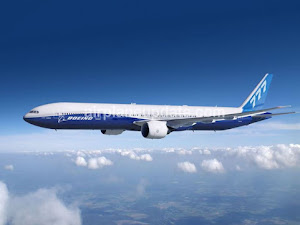
Description of Boeing 777-300ER
The Boeing 777-300ER was launched in February 2002 by Boeing and GE Aircraft Engine at the request of customers requesting aircraft with extra flexibility to serve non-stop routes ordered by passengers. On February 24, 2003, the Boeing 777-300ER made its first flight, and the FAA and EASA (European Aviation Safety Agency, successor to JAA) provided model certification on March 16, 2004.
The first model of the 777-300ER was launched with ten aircraft orders from Air France, along with additional commitments on April 29, 2004. In July 2004, Dubai-based Emirates agreed to buy 13 Boeing 777-300ER with four aircraft based on the company's order to be shipped during 2006 and the rest as an option to be sent from 2006 to 2012.
The first model of the 777-300ER was launched with ten aircraft orders from Air France, along with additional commitments on April 29, 2004. In July 2004, Dubai-based Emirates agreed to buy 13 Boeing 777-300ER with four aircraft based on the company's order to be shipped during 2006 and the rest as an option to be sent from 2006 to 2012.
Boeing combined several performance improvements for the 777-300ER version, developing its range and payload capabilities. The Boeing 777-300ER extends the capability range of the 777 family, bringing the efficiency and reliability of twin engines to the long-term market. This aircraft has a cruising capacity of up to 7,930 nautical miles (14,685 km). And it uses the configuration of two classes and three classes, each of which can accommodate between 339 and 370 passengers.
The Boeing 777-300ER has a mile-seat fee that is 18 to 20 percent lower than the A340-500 and A340-600 models. Fuel burns are much lower by 21 to 22 percent lower per seat for a distance of 777. When compared to A340-500 and A340-600. 777 also uses advanced technology that reduces maintenance costs and makes maintenance more efficient.
The 300ER version and freight ship use the General Electric GE90 standard engine. The GE Aircraft Engine produces engines for the 777-300ER aircraft specifically. The new engine is considered to be the most powerful commercial jet engine in the world and currently holds the Guinness World Record for thrust. But other engine models are also provided, namely Pratt & Whitney PW4000 and Rolls-Royce Trent 800.
Introducing a new wing design, General Electric GE90 engine, a more efficient and powerful Pratt & Whitney PW4000 or Rolls-Royce Trent 800 and a lighter structure, the 777 is a fuel-efficient aircraft. Fuel savings make it possible to offer lower prices to airline customers while minimizing environmental impacts.
The Boeing 777-300ER is equipped with an Electronic Flight Bag (EFB). EFB provides technological advantages for safe, safe and efficient operations. This includes onboard performance tools that allow pilots to instantly calculate ideal speed and engine settings for aircraft, under any weather conditions, on any runway with any load.
In addition, EFB includes the award-winning Jeppesen Airport Transfer Map application, which combines airport taxi charts with high fidelity, geographic references and appropriate navigation signals to show the flight crew right where they are at the airport surface. EFB was certified by the US Federal Aviation Administration (FAA) in October 2003 at the same time the first commercial unit was sent to KLM Royal Dutch Airlines in the airline's first 777.
Specification of Boeing 777-300ER
Dimensions
|
|
Length (m)
|
73.9
|
Wingspan (m)
|
64.8
|
Height (m)
|
18.6
|
Wing area (m2)
|
436.8
|
Weight
|
|
Maximum take-off
weight (kg)
|
317 520 - 351 800
|
Maximum landing
weight (kg)
|
251 290
|
Operating empty
weight (kg)
|
168 700
|
Maximum zero fuel
weight (kg)
|
237 680
|
Maximum payload (kg)
|
68 500
|
Standard fuel
capacity (L)
|
181 200
|
Performance
|
|
Range with max
payload (km)
|
11 390 - 14 600
|
Cruise speed (km/h)
|
905
|
Maximum speed (km/h)
|
945
|
Maximum operating
altitude (m)
|
13 100
|
Take-off field
length (m)
|
3 300
|
Landing field length
(m)
|
1 900
|
Engines
|
GE GE90-115B,
2 x 115000 lb |
Cabin Data
|
|
Passengers (1-class)
|
550
|
Passengers (2-class)
|
479
|
Passengers (3-class)
|
365
|
Cabin width (m)
|
5.87
|
Price of Boeing 777-300ER
The
price of Boeing 777-300ER is US$ 361.5M in 2018. The Price reflecting a range
of available options and configurations for each model. Configurations and
options that may affect price include performance capability, interiors,
avionics, fuel capacity, and others.








No comments:
Post a Comment